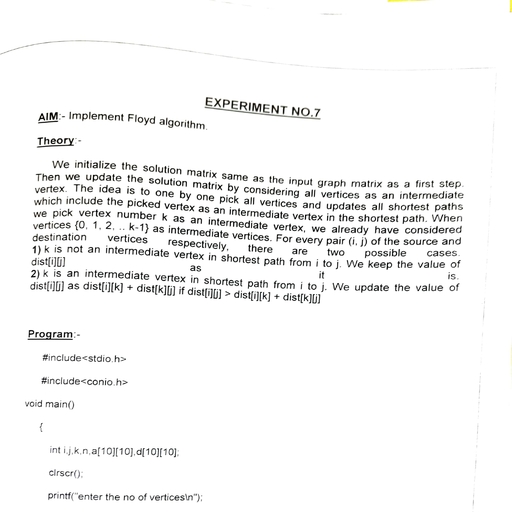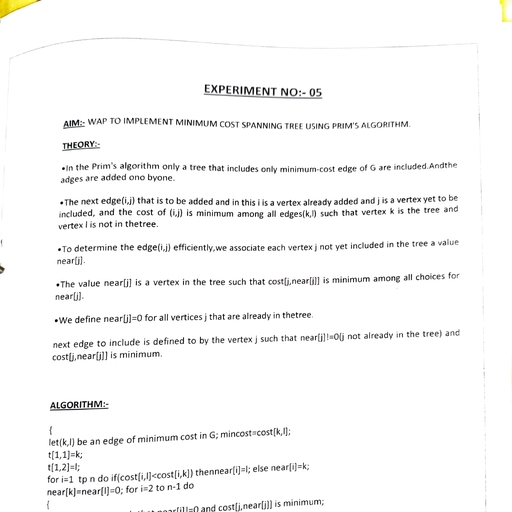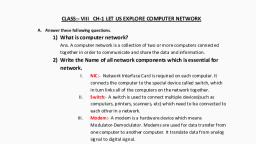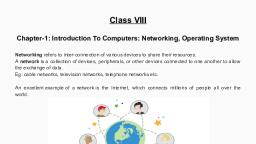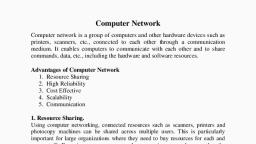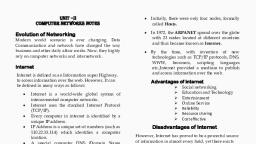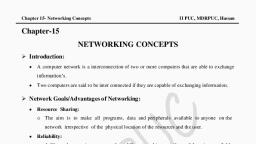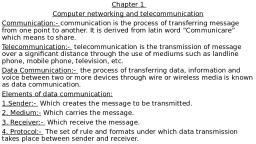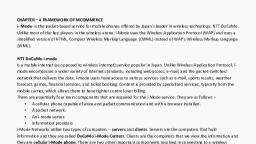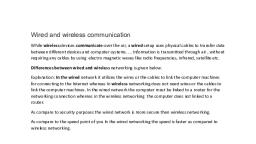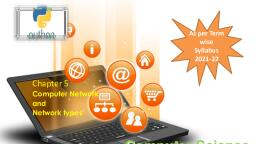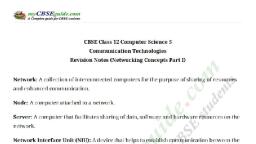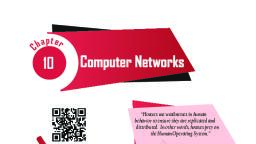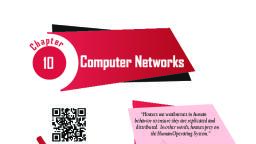Page 1 :
NETWORK ENVIRONMENT
Page 2 :
What is a Network?, A network consists of two or more computers that are linked in order to share resources (such as printers and CDs), exchange files, or allow electronic communications., The computers on a network may be linked through cables, telephone lines, radio waves, satellites, or infrared light beams., The best-known computer network is the Internet.
Page 4 :
What Do Networks Do?, Computer networks are used to carry out a large number of tasks through the sharing of information., Some of the things that networks are used for include:, Communicating using email, video, instant messaging and other methods, Sharing devices such as printers, scanners and photocopiers, Sharing files, Sharing software and operating programs on remote systems, Allowing network users to easily access and maintain information
Page 5 :
NETWORKING DEVICES, Hardware devices that are used to connect computers, printers, fax machines and other electronic devices to a network are called network devices. , These devices transfer data in a fast, secure and correct way over same or different networks. Network devices may be inter-network or intra-network., Some devices are installed on the device, like NIC card or RJ45 connector, whereas some are part of the network, like router, switch, etc.
Page 6 :
1) Network Interface Card:-, A network interface card (NIC) is a hardware component without which a computer cannot be connected over a network., It is a circuit board installed in a computer that provides a dedicated network connection to the computer. , The earliest NIC cards were external to the system and needed to be installed manually. In modern computer systems, it is an internal hardware component., The NIC has RJ45 socket where network cable is physically plugged in.
Page 8 :
Types Of Network Interface Cards, NIC cards are of two types −, Network Interface Card, Internal Network Card, External Network Card
Page 9 :
Internal Network Cards, In internal networks cards, motherboard has a slot for the network card where it can be inserted. , It requires network cables to provide network access., External Network Cards, In desktops and laptops that do not have an internal NIC, external NICs are used., External network cards are of two types: Wireless and USB based. , Wireless network card needs to be inserted into the motherboard, however no network cable is required to connect to the network. They are useful while traveling or accessing a wireless signal.
Page 10 :
2)HUB, Hubs are networking devices operating at a physical layer of the OSI model that are used to connect multiple devices in a network. , They are generally used to connect computers in a LAN., A hub has many ports in it. A computer which need to be connected to the network is plugged in to one of these ports. , When a data frame arrives at a port, it is broadcast to every other port, without considering whether it is destined for a particular destination device or not.
Page 12 :
Advantages of HUB, It can extend total distance of the network., It does not affect performance of the network seriously., It is cheaper., It can connect different media types.
Page 13 :
Disadvantages of Hub, A hub cannot filter data. It is a non-intelligent network device that sends message to all ports., Collisions may occurs during setup of transmission when more than one computers place data simultaneously in the corresponding ports., They generally have fewer ports of 4/12., They are passive devices, they don’t have any software associated with it.
Page 14 :
3) SWITCHES, A switch has many ports, to which computers are plugged in. , When a data frame arrives at any port of a network switch, it examines the destination address, performs necessary checks and sends the frame to the corresponding device(s)., It supports unicast, multicast as well as broadcast communications.
Page 16 :
Features:-, Switches are active devices, equipped with network software., Switches can perform some error checking before forwarding data to the destined port., Transmission mode is full duplex, i.e. communication in the channel occurs in both the directions at the same time. Due to this, collisions do not occur., The number of ports is higher – 24/48.
Page 17 :
Disadvantages:-, They are more expensive compare to network bridges., Network connectivity issues are difficult to be traced through the network switch., Proper design and configuration is needed in order to handle multicast packets.
Page 18 :
4) BRIDGES, A bridge is a network device that connects multiple LANs (local area networks) together to form a larger LAN. , The process of aggregating networks is called network bridging. , A bridge connects the different components so that they appear as parts of a single network. , Bridges operate at the data link layer of the OSI model and hence also referred as Layer 2 switches., The following diagram shows a bridges connecting two LANs −
Page 20 :
Advantages of bridge networking:, It reduces network traffic, It reduces collisions, Bridge connects similar network types with different cabling, Bridge increase the number of attached workstation and network segments, It extends the physical network, It connects different architecture, Bridges network can extend a network by acting as a repeater, It helps in an extension of physical network, Some bridges connect network having different architectures and media types
Page 21 :
Disadvantages of bridge networking:, It does not filter broadcasts, It is slower compare to repeaters due to the filtering process, It is more expensive compared to repeaters, Complex network topology, it can pose a problem for transparent bridge, A bridge is more expensive than repeaters or hubs', Does not limit the scope of broadcast , Does not scale to extremely large network, Buffering and processing introduces delays
Page 22 :
4) ROUTERS, A Router is a networking device that forwards data packets between computer network. , This device is usually connected to two or more different networks., When a data packet comes to a router port, the router reads address information in packet to determine out which port the packet will be sent.
Page 24 :
Features of Routers, It connects different networks together and sends data packets from one network to another., A router can be used both in LANs (Local Area Networks) and WANs (Wide Area Networks)., Router can determine best path/route for data to reach the destination., Disadvantages of Routers:-, Routers are more expensive than other networking devices like hubs, bridges and switches., Routers are slow as compared to switch, hub, bridges.
Page 25 :
5)MODEM, Modem is a device that enables a computer to send or receive data over telephone or cable lines. , The data stored on the computer is digital whereas a telephone line or cable wire can transmit only analog data., The main function of the modem is to convert digital signal into analog and vice versa. , Modem is a combination of two devices − modulator and demodulator. The modulator converts digital data into analog data when the data is being sent by the computer. The demodulator converts analog data signals into digital data when it is being received by the computer.
Page 26 :
Types of Modem, Depending on direction of data transmission, modem can be of these types −, Simplex − A simplex modem can transfer data in only one direction, from digital device to network (modulator) or network to digital device (demodulator)., Half duplex − A half-duplex modem has the capacity to transfer data in both the directions but only one at a time., Full duplex − A full duplex modem can transmit data in both the directions simultaneously.
Page 27 :
Advantages of the modem:, More useful in connecting LAN with the internet, Speed depends on the cost, A limited number of a system can be connected , A modem is most probably widely used in data communication roadway, A modem converts that the digital signal into an analog signal, Disadvantages of the modem:, Acts just as an interface between LAN and internet, No traffic maintenance is present, A modem is not understood the intermediate process, The modem does not know about the own destination path
Page 28 :
TYPES OF NETWORK, A computer network is a group of computers linked to each other that enables the computer to communicate with another computer and share their resources, data, and applications., A computer network can be categorized by their size. A computer network is mainly of four types:
Page 29 :
TYPES OF COMPUTER NETWORK, LAN, MAN, WAN, WLAN, LAN(Local Area Network), MAN(Metropolitan Area Network), WAN(Wide Area Network), WLAN(Wireless Local Area Network)
Page 30 :
1) LOCAL AREA NETWORK, Local Area Network is a group of computers connected to each other in a small area such as building, office., LAN is used for connecting two or more personal computers through a communication medium such as twisted pair, coaxial cable, etc., It is less costly as it is built with inexpensive hardware such as hubs, network adapters, and Ethernet cables., The data is transferred at an extremely faster rate in Local Area Network., Local Area Network provides higher security.
Page 32 :
Local area networks use either Wi-Fi or Ethernet to connect computer and devices in a network., A typical Wi-Fi LAN operates one or more wireless access points that devices within coverage area connect to. These access points, manage network traffic which is flowing to and from the connected devices. In our home, school, office’s LAN, wireless broadband routers perform the functions of an access point., A typical Ethernet LAN consisting of an ethernet cable to which all the machines are attached, like in our school labs, number of computers connected to each other through the common ethernet cable.
Page 33 :
Characteristics of Local Area Network, LANs are private owned-network, can be extended up to a few kilometers., LANs operate at relatively high speed as compared to the typical WAN, It connects computers within a single office, building, block or campus, i.e. they work in a relatively small geographical area.
Page 34 :
Advantages of LAN, Resource Sharing: LAN provides resource sharing such as computer resources like printers, scanners, modems, DVD-ROM drives, and hard disks can be shared within the connected devices. This reduces cost and hardware purchases., Software Applications Sharing: In a Local Area Network, it is easy to use the same software in a number of computers connected to a network instead of purchasing the separately licensed software for each client a network., Easy and Cheap Communication: Data and messages can easily be shared with the other computer connected to the network., Centralized Data: The data of all network users can be stored on a hard disk of the central/server computer. This help users to use any computer in a network to access the required data., Data Security: Since data is stored on the server computer, it will be easy to manage data at only one place and the data will be more secure too., Internet Sharing: Local Area Network provides the facility to share a single internet connection among all the LAN users. In school labs and internet Cafes, single internet connection is used to provide internet to all connected computers.
Page 35 :
Disadvantages of LAN, High Setup Cost: The initial setup costs of installing Local Area Networks is high because there is special software required to make a server. Also, communication devices like an ethernet cable, switches, hubs, routers, cables are costly., Privacy Violations: The LAN administrator can see and check personal data files of each and every LAN user. Moreover, he can view the computer and internet history of the LAN user., Data Security Threat: Unauthorised users can access important data of an office or campus if a server hard disk is not properly secured by the LAN administrator., LAN Maintenance Job: Local Area Network requires a LAN Administrator because there are problems such as software installations, program faults or hardware failures or cable disturbances in Local Area Network. A LAN Administrator is required to maintain these issues., Covers Limited Area: LANs are restricted in size they cover a small area like a single office, single building or a group of nearby buildings.
Page 36 :
2) MAN(Metropolitan Area Network), A metropolitan area network is a network that covers a larger geographic area by interconnecting a different LAN to form a larger network., Government agencies use MAN to connect to the citizens and private industries., In MAN, various LANs are connected to each other through a telephone exchange line., It has a higher range than Local Area Network(LAN).
Page 38 :
Advantages of a metropolitan area network (MAN), Less expensive:, It is less expensive to attach MAN with WAN. MAN gives the good efficiency of data. In MAN data is easily managed in a centralized way., Sending local emails:, On MAN you can send local emails fast and free., High speed than WAN:, MAN uses fiber optics so the speed of data can easily reach upon 1000 Mbps. Files and databases can be transferred fast., Sharing of the internet:, In some installation of MANs, users can share their internet connection. So multiple users can get the same high-speed internet., Conversion from LAN to MAN is easy:, MAN is a faster way to connect two fast LANs together. This is due to the fast configuration of links., High Security:, MAN has a high-security level than WAN.
Page 39 :
Disadvantages of metropolitan area network (MAN), Difficult to manage:, If MAN becomes bigger then it becomes difficult to manage it. This is due to a security problem and other extra configuration., Internet speed difference:, MAN cannot work on traditional phone copper wires. If MAN is installed on copper wires then there will be very low speed. So it required the high cost to set up fiber optics for the first time., Hackers attack:, In MAN there are high chances of attacking hackers on the network compared to LAN. So data may be leaked. Data can be secured but it needs high trained staff and security tools., Technical people required to set up:, To setup MAN it requires technical people that can correctly setup MAN. The technical people are network administrators and troubleshooters., More wires required:, In MAN additional cables are required to connect two LAN which is another problem.
Page 40 :
Examples of metropolitan area network (MAN), Used in government agencies, University campuses, In hospital, In airports, Used in public libraries
Page 41 :
WAN(Wide Area Network), A Wide Area Network is a network that extends over a large geographical area such as states or countries., A Wide Area Network is quite bigger network than the LAN., A Wide Area Network is not limited to a single location, but it spans over a large geographical area through a telephone line, fiber optic cable or satellite links., The internet is one of the biggest WAN in the world., A Wide Area Network is widely used in the field of Business, government, and education., Examples:-Mobile Broadband, Private Network
Page 43 :
Advantages Of Wide Area Network:, Geographical area: A Wide Area Network provides a large geographical area. Suppose if the branch of our office is in a different city then we can connect with them through WAN. , Centralized data: In case of WAN network, data is centralized. Therefore, we do not need to buy the emails, files or back up servers., Get updated files: Software companies work on the live server. Therefore, the programmers get the updated files within seconds., Exchange messages: In a WAN network, messages are transmitted fast. , Sharing of software and resources: In WAN network, we can share the software and other resources like a hard drive, RAM., Global business: We can do the business over the internet globally., High bandwidth: If we use the leased lines for our company then this gives the high bandwidth. The high bandwidth increases the data transfer rate which in turn increases the productivity of our company.
Page 44 :
Disadvantages of Wide Area Network:, Security issue: A WAN network has more security issues as compared to LAN and MAN network as all the technologies are combined together that creates the security problem., Needs Firewall & antivirus software: The data is transferred on the internet which can be changed or hacked by the hackers, so the firewall needs to be used. Some people can inject the virus in our system so antivirus is needed to protect from such a virus., High Setup cost: An installation cost of the WAN network is high as it involves the purchasing of routers, switches., Troubleshooting problems: It covers a large area so fixing the problem is difficult.
Page 45 :
WIRELESS LOCAL AREA NETWORK(WLAN), Wireless LANs (WLANs) are wireless computer networks that use high-frequency radio waves instead of cables for connecting the devices within a limited area forming LAN (Local Area Network). , Users connected by wireless LANs can move around within this limited area such as home, school, campus, office building, railway platform, etc., WLAN is used to make a limited network in school, home, campus, computer laboratory and office building.
Page 46 :
Advantages of wireless local area network (WLAN), As WLAN reduces physical wires so it is a flexible way of communication, WLAN also reduces the cost of ownership, It is easier to add or remove workstation, It provides high data rate due to small area coverage, Easy installation and you don’t need extra cables for installation
Page 47 :
Disadvantages of wireless local area network (WLAN), WLAN requires license., It has a limited area to cover.., If the number of connected devices increases then data transfer rate decreases., Attackers can get access to the transmitted data because wireless LAN has low data security., Chances of errors are high., Communication is not secure and can be accessed by unauthorized users.
Page 48 :
WIFI, Wi-Fi is a wireless networking technology that allows devices such as computers (laptops and desktops), mobile devices (smart phones), and other equipment (printers and video cameras) to interface with the Internet. , It allows these devices and many more to exchange information with one another, creating a network., Internet connectivity occurs through a wireless router. When you access Wi-Fi, you are connecting to a wireless router that allows your Wi-Fi-compatible devices to interface with the Internet.
Page 49 :
Advantages of Wifi��1. Convenience �Wireless networks allows multiple users to connect through the same network. This ease of use and convenience is not present in the wired networks., 2. Mobility �As long as you are in the range of a Wifi Access Point, with Wifi you can carry out your regular works from anywhere you want especially with the mobile devices. , 3. Productivity �Regardless of their location, staffs of a company can accomplish their assigned tasks with a Wifi network. As a result staffs can be more engaged and be able to deliver their timely targets and works, enhancing the overall productivity of the company., 4. Deployment The installation of a Wifi access point is relatively easy compared to a Wired network connection. Installing a new Wifi router is easy rather than fitting a complex cable network., 5. Expandability �Adding new users to a Wifi network is an easy task. more users can access the Wifi network. , 6. Cost �Compared to a Wired network connection, Wireless networks offer significant advantages in terms of cost and labour. Especially when installing a new Wifi network, you can cut down the expenses in wiring and maintenance.
Page 50 :
Disadvantages of Wifi, 1.Security ��Even though many encryption techniques are taken by the wireless networks, still the Wifi is vulnerable to hacking. wireless nature it has high chances of being hacked especially the Public Wifi networks.��2. Range ��Range offered by a Wifi network is limited, typically around 100-150 feet. While it is sufficient for a normal home, it can actually be a problem for building structures. ���3. Speed ��The speed of a Wifi connections are far more slower than a wired connection (around 1-54 Mbps).
Page 51 :
4. Reliability ��A Wifi network works in the frequency of 2.4Ghz. This frequency has high chances of getting hindered due to the electro magnetic waves and other forms of obstacles. As a result you may frequently experience connectivity issues and weak signal strengths.���5. Bandwidth ��Many routers only allows 30 maximum devices to be connected. The bandwidth of the Wifi network gets weaker as you add more devices. ��6. Health issues � Wifi that i causes health issues in human, Some of them are cancer, insomnia and apoptosis. Same as the effects caused from the Microwave frequencies (EMF).
Page 52 :
BLUETOOTH, The Bluetooth technology is a wireless technology, it is used to transfer the data between the different electronic devices. , The distance is very less to transfer the data between the two electronic devices. , This technology does not require any cables, cords, and adapters to communicate with other devices.
Page 53 :
Advantages of Bluetooth:-, It has lower power consumption., Bluetooth devices are available at very cheap cost., It is easily upgradeable., It is possible to use Bluetooth for both transferring of data and verbal communication., It avoids interference from other wireless devices.
Page 54 :
Disadvantages of Bluetooth:-, It can lose connection in certain conditions., It has low bandwidth as compared to Wi-Fi., It allows only short range communication between devices., Security is a very key aspect as it can be hacked.




